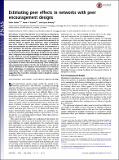Estimating peer effects in networks with peer encouragement designs
Author(s)
Kizilcec, René F.; Bakshy, Eytan; Eckles, Dean Griffin
DownloadEstimating peer effects.pdf (779.1Kb)
PUBLISHER_POLICY
Publisher Policy
Article is made available in accordance with the publisher's policy and may be subject to US copyright law. Please refer to the publisher's site for terms of use.
Terms of use
Metadata
Show full item recordAbstract
Peer effects, in which the behavior of an individual is affected by the behavior of their peers, are central to social science. Because peer effects are often confounded with homophily and common external causes, recent work has used randomized experiments to estimate effects of specific peer behaviors. These experiments have often relied on the experimenter being able to randomly modulate mechanisms by which peer behavior is transmitted to a focal individual. We describe experimental designs that instead randomly assign individuals’ peers to encouragements to behaviors that directly affect those individuals. We illustrate this method with a large peer encouragement design on Facebook for estimating the effects of receiving feedback from peers on posts shared by focal individuals. We find evidence for substantial effects of receiving marginal feedback on multiple behaviors, including giving feedback to others and continued posting. These findings provide experimental evidence for the role of behaviors directed at specific individuals in the adoption and continued use of communication technologies. In comparison, observational estimates differ substantially, both underestimating and overestimating effects, suggesting that researchers and policy makers should be cautious in relying on them.
Date issued
2016-07Department
Sloan School of ManagementJournal
Proceedings of the National Academy of Sciences
Publisher
National Academy of Sciences (U.S.)
Citation
Eckles, Dean; Kizilcec, René F. and Bakshy, Eytan. “Estimating Peer Effects in Networks with Peer Encouragement Designs.” Proceedings of the National Academy of Sciences 113, no. 27 (July 2016): 7316–7322. © 2016 National Academy of Sciences
Version: Final published version
ISSN
0027-8424
1091-6490